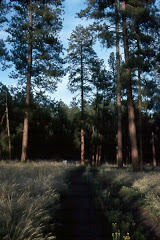Historical Context:
Over three thousand people have registered for this year's three-day conference. This is the fifteenth year for the conference that originally started with a small group of individuals at the National Geographic Society. The conference has been sponsored by ESRI and other GIS-industry companies down through the years.
Highlights:
Jack Dangermond characterized this year’s conference as “The Geographic Approach for the Nation.” He captured the GIS past in pictures with music in telling a story as to the contemporary context for applying GIS today. As always his message is one tinged in hope of being able to surmount the many cultural and societal obstacles in our day by using and applying geographic-based tools. He cited a multitude of applications across a seemingly widening array of military, business and natural resource fields. Jack drilled into a number of applications during his talk on natural resources, homeland security, facility management, military applications and law enforcement to name just a few.
The conference plenary speaker, Dr. John Holdren (President Obama’s Science and Technology Advisor and the Director of the White House Office of Science and Technology Policy), gave an effective and professional presentation on this Administration’s policies toward Science and Technology. I came away from his talk impressed. Editorializing on my own, “Science is too important not to have someone of Dr. Holdren’s stature in an advisory role to the President.”
ESRI web information on Dr. Holdren – Trained in aerospace engineering and theoretical plasma physics at the Massachusetts Institute of Technology and Stanford University, he is a member of the U.S. National Academy of Sciences, the U.S. National Academy of Engineering, and the American Academy of Arts and Sciences, as well as a foreign member of the Royal Society of London and a former President of the American Association for the Advancement of Science. Prior to joining the Obama administration, Dr. Holdren was a professor in both the Kennedy School of Government and the Department of Earth and Planetary Sciences at Harvard University, as well as Director of the independent, non-profit Woods Hole Research Center. From 1973 to 1996 he was on the faculty of the University of California, Berkeley, where he co-founded and co-led the interdisciplinary graduate-degree program in energy and resources.
Finally, every year Jack selects an individual in the Federal government who epitomizes the public servant who applies GIS in real world contexts. This year Jack honored Tim Trainor, Chief of the Geography Division, in the US Census Bureau for his work over the years.
Workshops (1 ½ hour sessions):
I personally attended workshops on ArcGIS Explorer–More than an Introduction with Brian Szukalski, Geodatabase Essentials Part 2–An Introduction to to ArcSDE Geodatabase with Tim Clark, Concepts of Geographic Analysis with Mike Sweeney, GeoMedicine with Bill Davenhall, and Using Spatial Statistics and Regression Analysis in ArcGIS with Laura Rosenshein.
ArcGIS Explorer – Brian focused on the new features coming out in March as part of the 1200 Build (a Silverlight Build will be released in April and a second Build 1500 will appear with the ArcGIS 10 summer release). This is a “connected application” that, because of its ability to be customized (as part of an Application Configuration Manager or ACM), holds potential as an enterprise-wide application for “the masses.” Brian discussed ArcGIS Explorer’s use of Microsoft’s ribbon interface. He also demonstrated the use layer packages and the ability to encapsulate data and symbology (recommended). The ArcGIS Explorer projection utilizes the Web Mercator auxiliary sphere that is used by Google. It is a 256 x 256 tiling scheme that is easy for mashing. The basemap gallery has also been updated for the new release. There was way too much information presented to cover here, but go to ESRI’s Resource Center for more information.
ArcSDE Geodatabases – Tim Clark covered a lot of ground that many of you are probably already familiar with. I won’t go into any details, but you can navigate to the ESRI web site for more information.
Concepts of Geographic Analysis – Mike Sweeney’s talk was focused on the basics for doing geographic analysis. Since all of us use geographic analysis on a regular basis through ArcGIS Toolbox I won’t mention the basics of his presentation. It is good to know though that there are a plethora of resources through the web (for example, ESRI’s help resources have improved over the years), in books (ESRI’s especially and including ESRI’s library), or at various governmental agencies (such as USGS, etc). Simply google/yahoo/search the web and read to your heart’s content. And don’t forget some of the blogs that are out there. They are excellent resources. In terms of blogs check out these – ESRI, James Fee, Michalis Avraam, Lizard Tech, and the Geo-Jobe blog to name just a few.
GeoMedicine –Bill Davenhall (see TEDMED talk) covered a lot of ground in emphasizing the importance of geography to your personal health. For more information, and to create your own map, go to the ESRI web site on GeoMedicine.
Using Spatial Statistics and Regression Analysis in ArcGIS – Laura Rosenshein gave two 1 ½ hour sessions on “Using Spatial Statistics” and “Regression Analysis in ArcGIS,” respectively. They were excellent session that I particularly had an interest in. What made the sessions even better is that she used ArcGIS 9.3.1 and ArcToolbox the whole time. In the Spatial Statistics session Laura focused on first, descriptive then inferential statistics. You can access here her Powerpoint on Spatial Statistics in a health care context for a good idea in terms of what she presented in the workshop. The second workshop was devoted to Regression Analysis in ArcGIS. Here is a link to an ESRI tutorial on Regression Analysis. Laura also demonstrated the use of Group Animation. She made it look easy (recommended). [As an aside click here for an interesting read in Directions Magazine about Laura and her career choice. Another aside, Laura mentioned she had someone ask her how fast of a computer do you need to run ArcGIS Desktop. Laura said it “depends on how fast you want ArcMap to work.”]
Reception:
The annual Fed User Thursday evening reception was held at the National Building Museum in DC. Sponsored by ESRI and other “GIS firms,” the reception was an incredible way to network in a beautiful venue. Regretfully, I missed my opportunity to meet the WWII Navajo Code Talkers who happened to be there for another meeting.
Geographic Serendipity:
As always there is some geographic serendipitous occurrence during the three day conference. My choice for 2010 is of a friend who wanted to go on a White House Tour. The day before he was to leave for DC from his Minnesota home and workplace he received an email from his Congressman that yes, indeed he would be able to go on a White House tour the next day (after he had been turned down). As luck would have it, my friend, happened to notice that the Dalai Lama was on the other side of the roped off area enjoying a White House tour with a staffer at the same time that his tour group entered the room.
Closing Session:
Damian Spangrud emceed the closing session in talking about Mobile GIS and Imagery with the help of demonstrations (including one using an iPhone).
Following Damian, Jack gave his customary closing for the conference as he interacted with participants and asked for input on the 2011 conference (slated for February 2nd through the 4th).
It was a great conference and I am already looking forward to next year and the glorious evening reception that Jack has made into a “Where’s Waldo…” Highly recommended for all GIS users!


